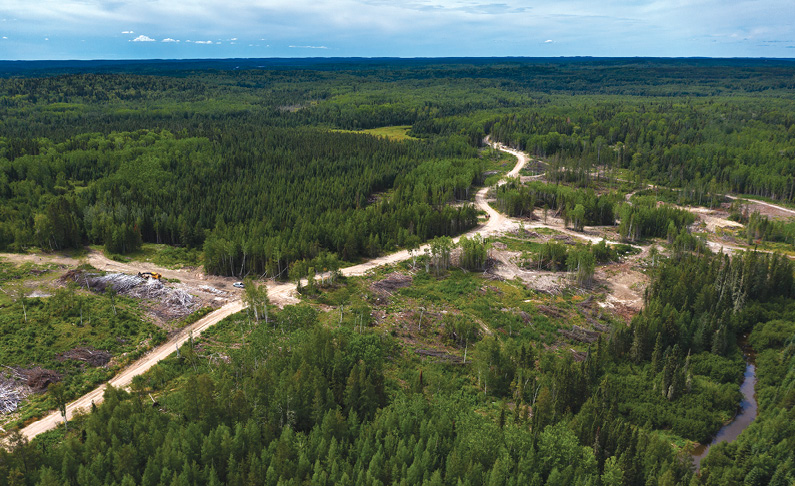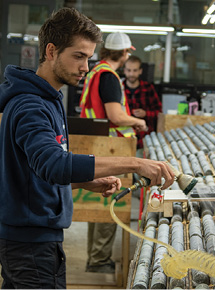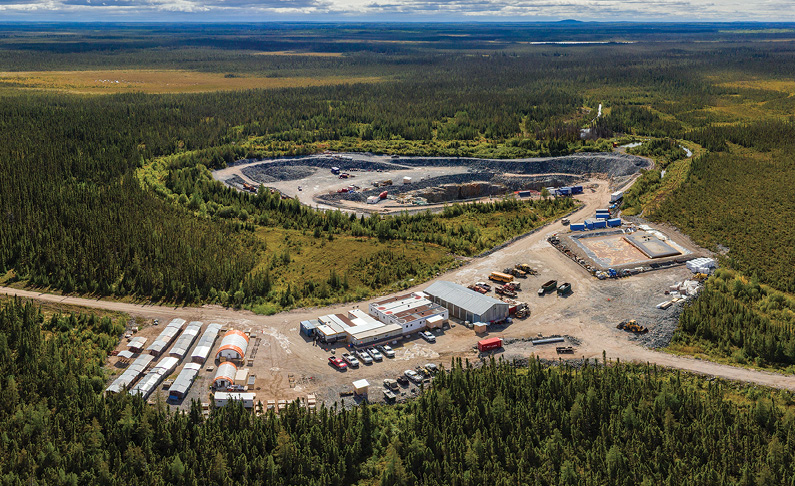A strong gold price has sent the size of Canada’s biggest gold exploration drill campaigns soaring to new heights
Gold exploration in Canada is on the upswing. A strong rise in the yellow metal’s price leading up to the August 2020 peak above US$2,000 per oz. has spurred on exploration in Canada that may lead to the nation’s next new mines.
It’s also had the effect of supersizing drill programs for juniors with promising discoveries, savvy management and talented exploration teams. There are now several juniors carrying out supersized drill programs involving 100,000 metres or more in a single year – in many cases before a resource has been compiled for the project.
Here’s our look at four such projects.
Amex Exploration
Perron project, Quebec
2021 DRILLING: 180,000 metres
INITIAL RESOURCE: Late 2021
Amex Exploration plans to wrap up a mammoth 300,000-metre drill program at its Perron project in Quebec this fall, and then begin work on a property-wide resource calculation. Incorporated into that resource will be data from 120,000 metres Amex completed to the end of 2020, and another 120,000 metres planned this year up until October, when work on the resource will begin.
Amex first optioned Perron in 1996 before earning a 100% interest in the project. The junior has made several discoveries since 2013, but exploration really picked up speed in November 2019, when Amex announced it would expand a planned 40,000-metre drill program to 100,000 metres on the back of high-grade results from multiple zones. The project is located 110 km north of Rouyn-Noranda in Quebec’s Abitibi region, near the village of Normétal.
Amex has defined four deposits along the Perron Fault, within a 3.6-km mineralized corridor at the 45.6-sq.-km project. These include the Eastern Gold zone, which includes the High Grade zone and Denise zone; the Gratien gold zone (discovered in the 90s by Falconbridge); the Central Polymetallic zone; and the Grey Cat gold zone.
Amex’s drill program has focused on expanding, linking and infill drilling at the three known orogenic gold zones, which contain a mixture of high-grade and disseminated gold.
So far, it has defined the High Grade zone from near surface to more than 1,250 metres depth, with intercepted core widths averaging 7 metres. Drill highlights from the zone released in April included 9.7 metres of 10.63 g/t gold starting at 560 metres vertical depth (hole 245), and previous drilling has returned up to 8.5 metres of 56.75 g/t gold (hole PE-19-27).
The Denise zone, a broad zone of gold mineralization with open pit potential, has returned hits such as 88 metres of 1.44 g/t gold starting at 150 metres (hole 237), as well as higher grade intervals (32.2 metres of 6.99 g/t gold) at depth. The zone extends for at least 600 metres vertically, starting at surface, and across a strike length of 300 metres. (True widths are estimated at 65-85% of reported widths and grades are not capped).
The project also contains an existing small inferred resource at Gratien from May 2009, totalling 69,907 oz. gold in 1.2 million tonnes grading 1.86 g/t.
While its primary focus is on gold, in August, Amex discovered a new high-grade, copper-rich volcanogenic massive sulphide (VMS) zone at Perron. Drilling returned 7.8 metres of 2.4% copper, 0.72% zinc, 0.27 g/t gold, and 22.15 g/t silver, including 4.4 metres of 3.92% copper, 1.2% zinc, 0.39 g/t gold and 35.99 g/t silver, and within that, 0.9-metre of 6.94% copper, 4.65% zinc, 0.3 g/t gold and 73 g/t silver.

CREDIT: GREAT BEAR RESOURCES
Great Bear Resources
Dixie project, Ontario
2021 DRILLING: 175,000 metres
INITIAL RESOURCE: Q1 2022
Great Bear Resources first started drilling at its Dixie gold project 25 km southeast of Red Lake, Ont., in the summer of 2017. Four years later, the junior has not yet delivered a resource. However, that hasn’t stopped Great Bear from raising funds for one of the biggest exploration programs in Canada.
On the heels of a $23-million, 112,000-metre drill program completed in 2020, this year, the company has budgeted $45 million for at least 175,000 metres.
Great Bear made the LP Fault discovery at Dixie in May 2019, with hole DNW-011 returning 14 metres of 12.33 g/t gold. Since then the company has drilled holes along 11 km of strike – each one returning gold.
At the end of July, the junior finally completed its massive phase 1 drilling program at Dixie – with 440 holes drilled over 4 km of the LP Fault to an average depth of 450 metres.
An initial resource for Dixie is due out early next year, focusing on the top 450 metres of mineralization from surface at the LP Fault, extending over 4 km. A preliminary economic assessment will follow. In total, Great Bear has drilled 630 holes totalling 283,000 metres at the 91.4-sq.-km project.
Given the massive scale of its drill program, and the scale of its discovery at Dixie, the market is expecting a hefty resource (the company’s market cap was around $770 million at press time).
Recent highlights from drilling include 43.1 metres of 3.83 g/t gold from 311.5 metres downhole in the northwestern area of the resource drilling grid (hole BR-394). The interval contained 4.8 metres of 28.18 g/t gold, and within that, 0.8 metre of 150 g/t gold. An infill hole (BR-272) returned 13.1 metres of 10.5 g/t gold from 313.2 metres downhole, including 3.7 metres of 33.35 g/t gold.
Dixie contains the classic high-grade Red Lake style of gold mineralization in quartz veins and silica replacement zones hosted in mafic volcanic rocks and localized near regional-scale D2 fold axes.
It also hosts high-grade disseminated gold with broad moderate- to lower-grade envelopes, hosted in light-coloured felsic volcanic rocks – the type of mineralization found at the LP Fault.
Drilling has confirmed that bulk tonnage gold mineralization at the LP Fault is continuous for more than 3 km of strike. The company says it is modelling 23 high grade domains and seven bulk tonnage, lower grade domains for inclusion in the upcoming resource.

CREDIT: NEW FOUND GOLD
New Found Gold
Queensway project, Newfoundland
2021 DRILLING: Up to 200,000 metres
INITIAL RESOURCE: TBA
New Found Gold first caused a stir in early 2020 when it reported its first high-grade gold hits from drilling at its Queensway project, 15 km west of Gander, Nfld. Its Keats zone discovery hole, drilled in November 2019 and reported in January 2020, hit an eye-popping 19 metres of 92.2 g/t gold starting at 96 metres downhole.
The company completed an initial public offering in August 2020, and began a 100,000-metre program. Following the release of more high-grade results at Keats and the discovery of the Lotto zone, 2 km north, in October 2020, the program was expanded to 200,000 metres in early 2021. More recently, New Found made the Golden Joint discovery, located in between the two other zones. Drilling there intersected 5.3 metres of 430.17 g/t gold from 223.5 metres downhole in hole 241.
Nine rigs were onsite in August at the 1,500-sq.-km property, with another planned to be added in the third quarter.
In mid-August, New Found had completed 37.5% of its 200,000 drill program (or more than 75,000 metres), with 13,000 metres completed last year. (It’s not clear if the program will conclude this year or carry into 2022.)
The Queensway project hosts two parallel, northeast-trending faults: the Appleton Fault zone, which hosts auriferous quartz veins within shale and greywacke and the JBP Fault zone, which contains a sedimentary hosted quartz vein system. The majority of drilling has been focused on a 2-km corridor between the Keats and Lotto zone along the Appleton Fault North.
New Found has not indicated when it believes it might have enough information for an initial resource. However, it does believe that it could be looking at a system similar to Kirkland Lake Gold’s Fosterville mine in Australia, which features high-grade, structurally hosted epizonal gold.
The property has seen previous exploration, with about 21,000 metres of drilling in the mid-1980s to 2012. The Knob zone on the Appleton Fault zone contains a historic resource of 77,943 oz. gold at 10.3 g/t gold.
New Found Gold’s exploration targeting program – including its initial discovery – have been supported by GoldSpot Discoveries’ artificial intelligence technology. The two companies share cofounders in New Found Gold president Dennis Laviolette and executive chairman Collin Kettell.

Quebec in the third quarter. CREDIT: WALLBRIDGE MINING
Wallbridge Mining
Fenelon project, Quebec
2021 DRILLING: 170,000 metres
INITIAL RESOURCE: Q3 2021
Wallbridge Mining is getting ready to release its first large-scale resource estimate from the Fenelon project, 75 km northwest of Matagami in Quebec, by the end of September.
Fenelon is on the Detour-Fenelon Gold trend, part of the eastern extension of the Sunday Lake Deformation zone, an east-west structure in the northern Abitibi greenstone belt.
Wallbridge purchased the project in 2016, but only consolidated the Fenelon land package last year through an all-share takeover of Balmoral Resources. The purchase expanded the property to 85.6 sq. km from 10.5 sq. km, and gave Wallbridge access to additional underground infrastructure, extensions of identified zones, and a water treatment plant.
With the company completing 100,000 metres of drilling last year and 65,000 metres to date in 2021, the upcoming resource will incorporate a total of 260,000 metres drilled in the last three years. (The junior is planning a total of 170,000 metres for 2021 with a budget of $80 million.)
Previous work at Fenelon includes a 2017 prefeasiblity study on the Main Gabbro zones, which were originally discovered in 1994. The study outlined a modest 18-month mine life, based on measured and indicated resources of 96,721 tonnes grading 12.97 g/t gold for 38,000 oz. (at a 5 g/t cutoff grade.) Wallbridge also took a bulk sample at the project in 2019, using existing ramp infrastructure at the Main Gabbro zones. The 33,233-tonne sample yielded a reconciled average grade of 18.49 g/t gold for 19,755 oz.
While drilling has extended the Fenelon gold system to 1.8 km of strike, the upcoming resource will focus on a 1 km by 1.2 km area down a depth of about 1,000 metres. The resource will include the high-grade Gabbro shear zones, as well as discoveries Wallbridge has made at Fenelon: Area 51, a vein network of broad, low-grade mineralization, and the high-grade Tabasco/Cayenne shear zones.
The Tabasco/Cayenne zones are bulk mineable zones with tens of metres of high-grade (6 to 40 g/t), medium-grade and low-grade mineralization (1 to 3 g/t). Mineralized corridors in Area 51 are typically 10 to 50 metres wide with an average grade of 1 to 2 g/t gold.
In April, Wallbridge reported the discovery of an eastern extension of the Gabbro zones. Drilling intersected 16.4 metres of 17.7 g/t gold, including 3.3 metres of 76.98 g/t gold.
The company is also planning 10,000 metres of underground development over three years to faciliate drilling.
Read the Full Article at CANADIAN MINING JOURNAL

